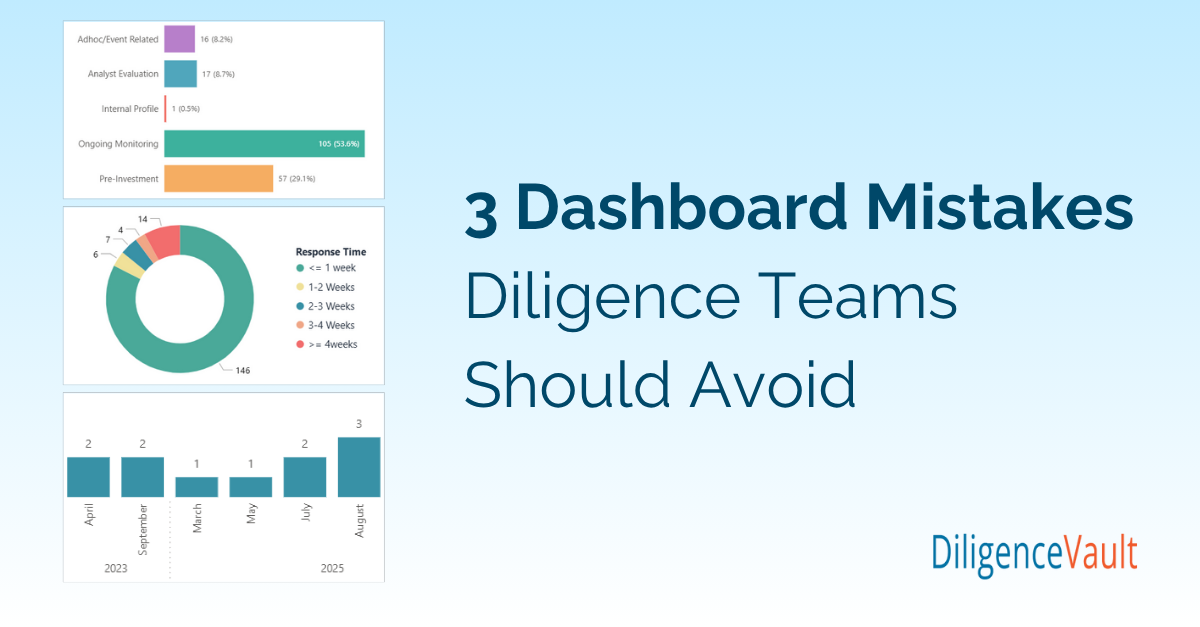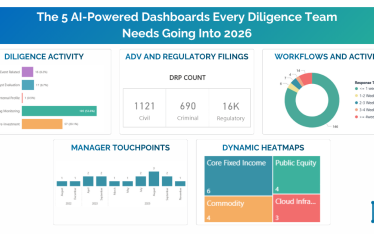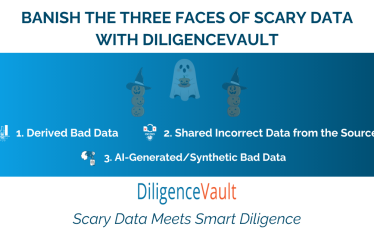Part Two in the Year-End Dashboard Series
In Part One of this series, we outlined the five AI-powered dashboards every diligence team needs heading into 2026. But here’s the reality: having dashboards and actually using them are two entirely different outcomes.
We’ve watched teams invest significant time building dashboards only to abandon them within weeks. The mistakes that derail dashboards depend heavily on your team’s size and technical capabilities. A three-person family office faces different challenges than a 30-person FoF diligence team.
If You’re a Small Team with Limited Tech Bandwidth
Mistake 1: Trying to Show Everything
When you have limited bandwidth, dashboard clutter is fatal. A family office tracking 18 different metrics may find that within six weeks, no one checks the dashboard anymore.
A three-person diligence team can reduce their Activity Dashboard to five metrics: reviews overdue, reviews in progress this week, managers awaiting response for more than 10 days, upcoming reviews in the next 30 days, and average turnaround time. The dashboard can take less than two minutes to scan each morning, and adoption stayed high.
The Principle: Focus beats comprehensiveness, especially when resources are limited.
Mistake 2: Building Dashboards That Require Manual Data Entry
If your dashboard depends on someone manually updating spreadsheets, it won’t survive past Q1. Small teams don’t have bandwidth for manual data maintenance.
Small diligence teams need platforms that automate data collection: comprehensive data networks tracking thousands of managers, direct ADV integrations that update in real-time, and AI-powered document extraction that converts unstructured PDFs into structured data without manual tagging.
A small RIA moved to a platform with built-in ADV monitoring and AI extraction. Their regulatory dashboard updates automatically whenever a manager updates their ADV filing. Their structured data dashboard populates directly from questionnaire responses and document analysis. Result? They now monitor 40 managers with the same bandwidth they previously used to track 15, redirecting 10 hours per week from data maintenance to actual analysis.
The Principle: For small teams, automation isn’t a luxury, but it’s survival.
Mistake 3: Not Embedding Dashboards Into Existing Workflows
Small teams can’t afford a separate system that requires a separate login. If it’s one more thing to check, it won’t get checked.
A small pension team transformed their Monday morning meeting by projecting their Activity Dashboard for the first 10 minutes. The meeting opens with current reviews, stalled managers, and upcoming deadlines. No more asking “where are we on the XYZ review?” The dashboard became the single source of truth that starts every week.
The Principle: Dashboards only work when they’re built into how teams already operate.
If You’re a Large Team with Tech Capabilities
Mistake 1: Building Without Context
When you can build anything, the risk is building sophisticated dashboards that don’t map to how decisions actually get made.
Different stakeholders need different context. Manager Research focuses on opportunities. The CIO focuses on decisions. ODD and Compliance focus on risk. The COO focuses on efficiency. One dashboard rarely serves all four perspectives well.
A global allocator created four connected views instead of one master dashboard: Manager Research sees pipeline activity and new manager pitches. The CIO sees portfolio-level heatmaps and decision-ready IC summaries. ODD sees regulatory filing alerts and documentation gaps. The COO sees review cycle times and workflow bottlenecks.
Result? Manager Research stopped missing opportunities buried in a complex dashboard. The CIO stopped requesting custom reports before IC meetings. ODD caught regulatory issues within 48 hours of filing. The COO cut average review time by 21%.
The Principle: Different roles need different lenses on the same underlying data.
Mistake 2: Building Before Fixing Data Quality
Large teams can build beautiful dashboards on inconsistent, incomplete data. Bad data presented confidently leads to bad decisions made with false confidence.
A consultant fund with 500+ manager relationships spent six months fixing their data foundation with DiligenceVault before launching dashboards. They implemented a platform with ADV monitoring tracking 20,000+ advisers, automated filing change alerts, and are now including AI extraction that reads fund documents and side letters to populate structured fields, no more manual tagging or inconsistent data entry.
Result? Their dashboards became trusted, and heavily used.
The Principle: Data quality isn’t a nice-to-have. It’s the foundation of all decisions.
Mistake 3: No Clear Ownership or Governance
When dashboards are “everyone’s responsibility,” they become no one’s responsibility. Metrics stop updating. Definitions drift. Trust evaporates.
A global allocator assigned a “Dashboard Owner” role to a senior analyst. This person doesn’t build every dashboard, but owns the governance: periodic data quality checks, regular user feedback sessions with DiligenceVault, quarterly reviews, and direct accountability for accuracy and relevance.
Result? Dashboard adoption stayed high. Issues got resolved quickly. Users trusted the data. Dashboards evolved based on how teams actually used them.
The Principle: Large teams need explicit governance to prevent dashboard decay.
What This Means for 2026
Small teams win by staying focused, automating data collection, and embedding dashboards into existing workflows. Large teams win by building around stakeholder context, investing in data quality first, and establishing clear ownership.
Both paths require the same discipline: understanding why dashboards fail and designing intentionally to avoid those traps.
Because 2026 isn’t about collecting more data. It’s about drawing better conclusions, faster, and operating with confidence. The most successful diligence teams will be the ones who see clearly.
If you’re thinking about how to strengthen your diligence program heading into the new year, we’d be happy to share what we’re seeing across the industry and walk through examples of dashboards that genuinely move the needle.
2026 is going to be the year of insight. The teams that win will be the ones that see clearly.
Book a 15-minute walkthrough and see how these principles come to life in your own data.



